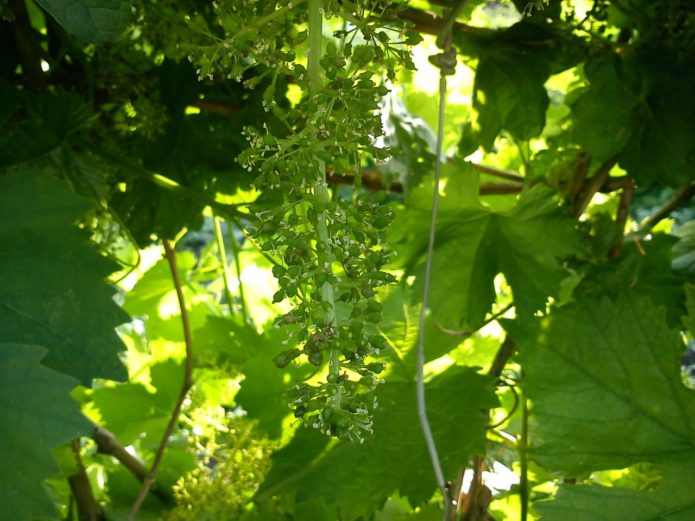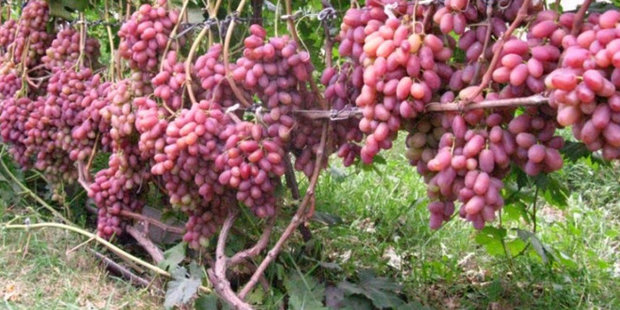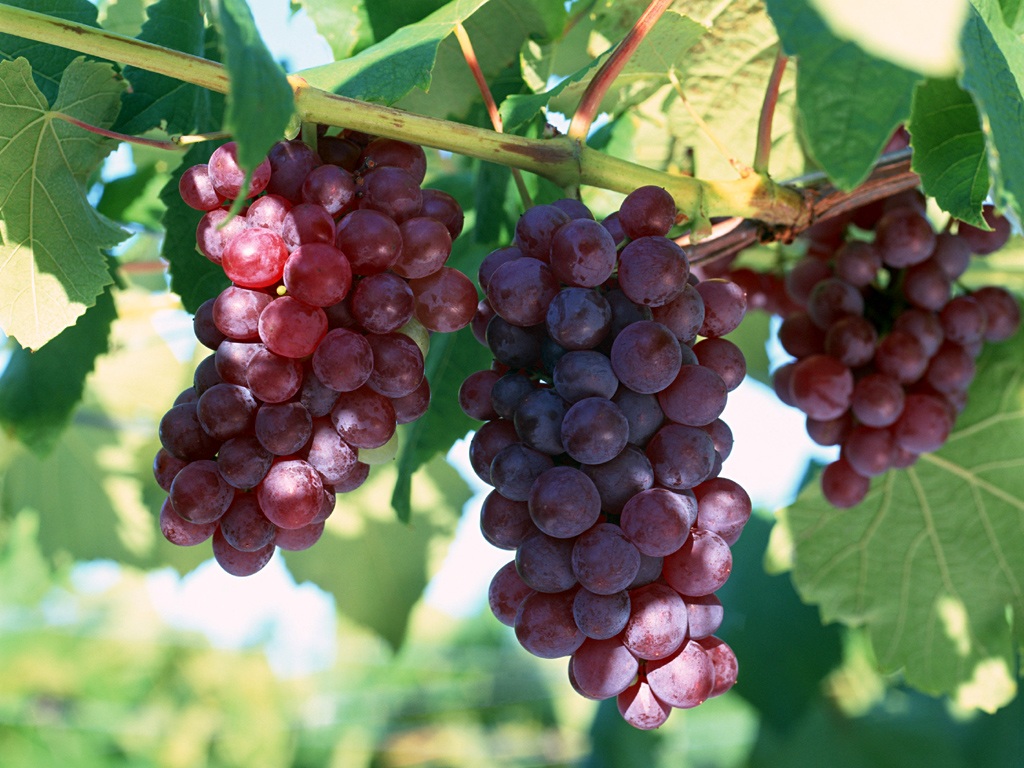The science of grape varieties, ampelography, was created by the Greeks. With the Roman conquerors Gauls and Germans joined the culture of winemaking and viticulture. The Romans expanded the boundaries of the cultivation of this berry. But they hardly expected that grape varieties and hybrids would develop territories with a climate where they had never dreamed of viticulture before. An example of such an expansion is the Transfiguration grape, the size of the bunches and the yield of which excites the imagination of gardeners.
Content
Breeding history, description and characteristics of the grape variety Transfiguration
To grow grapes, you need an abundance of light and heat, as well as life-giving moisture to fill each berry with juice. The main threat to vineyards is frost, especially late spring frosts, when the bushes woke up and sap flow began. Due to climatic features, there are not many areas in Russia where grapes are grown. It:
- North Caucasian region, the most favorable for cultivation;
- Nizhnevolzhsky;
- Central black earth;
- Uralsky.
The peculiarity of the early table grapes Transformation is that it grows in all zones of Russia where grapes are grown. Included in the State Register since 2014.
The authors of the variety - Rostov breeders Ivan Aleksandrovich Kostrikin, Leonid Petrovich Troshin, Vladimir Aleksandrovich Volynkin, Lyudmila Alekseevna Maistrenko, Vladimir Vladimirovich Likhovskoy and Viktor Nikolaevich Krainov, created grapes of amazing beauty. In many forums, the variety is referred to as Krainovsky.
Grape bushes Medium size transformation. Leaves are usually five-lobed, medium dissected, small. Three-bladed are less common. The surface of the leaf blade is smooth, without pubescence.
Bisexual flowers give rise to huge racemes, the average weight of which is nearly 800 g. Giant bunches weighing up to three kilograms are described.
The bunch is conical or cylindro-conical. The berries are large, cylindrical, pink, with dense pulp filled with transparent juice. The weight of one berry is up to 11 g, each contains 2-3 small seeds. The tasters give 8.5 points to fresh bunches of the Transfiguration. The better the bushes are lit, the brighter the blush on the brushes. The variety is recommended for table use. It tolerates transportation well.
The peculiarity of the variety is the very early ripening of berries and high yield. On average, 236 centners of juicy grapes are harvested per hectare. Gardeners note the unpretentiousness of the variety, as well as its high frost resistance. The incidence of diseases is average. Grape Transfiguration belongs to the covering varieties.
Preventive and therapeutic treatments of vineyards against diseases and pests make it possible to get a good harvest:https://flowers.bigbadmole.com/en/yagody/vinograd/obrabotka-vinograda-osenyu.html
Features of planting, pruning and growing grape varieties Transformation
For planting grapes, select areas where the groundwater level is not closer than one and a half meters. On the north side, the bushes protect from the wind. It is preferable to plant grapes on the south side of the buildings. The intensity of the color and taste of the grapes Transformation depends on the degree of illumination of the site. The more light falls on the bunch, the more intense the blush and the sweeter the berries, therefore they avoid the neighborhood with large trees.
Grapes of spring planting take root best of all. To do this, you need to purchase seedlings in advance or prepare the cuttings yourself.
Video: Vladimir Mayer shows how the cuttings of Transfiguration grapes look, ready for planting
For planting grapes, they dig a hole, plant a stalk and close up the hole. But as they say, skill is in the details.
Depending on the composition of the soil, the size of the pit is chosen. On light drained soils, they often do not dig a hole, but take out the soil layer with the help of a drill. A soil mixture with humus is added to the resulting space and a cutting is planted. If the soil is clay, dig a hole 40–50 cm deep and 50 cm in diameter. Separate the top fertile layer and mix with humus in a 1: 1 combination. The clay is separated and removed from the site.
And then:
- Crushed stone is poured to the bottom to a height of 10-15 cm.
- Then comes the soil-humus mixture.
- The cutting is planted at an angle.
- Fill the hole by compacting the soil tightly.
- Water and mulch the irrigation hole.
In any case, they try to make the depth of the hole twice the length of the roots of the seedling.
Ideal for planting grapes in a sunny area, illuminated all day and closed from the north by curtain plants or a fence:https://flowers.bigbadmole.com/en/yagody/vinograd/kak-posadit-vinograd.html
Video: S.V. Ksenofontov tells how to plant grapes and why the stalk is planted at an angle
If you plant the cutting in a large plastic container before planting in the ground, you can get a quick harvest. So the earthy clod warms up faster, and the root system of the grapes will grow better. However, all these tricks are needed only when planting grapes in the Central Region.
After planting, they try not to let the grapes bush, leaving only two shoots. The stepsons are removed. Due to this, the intensive growth of the main shoots is ensured. Around August, the shoots are pruned to stop their growth and allow them to stiffen. If you tighten it up with pruning, then unripe shoots will go away in the winter, which will freeze and may die. The grapes are cut in autumn up to the fifth kidney or up to half a meter high.
In the spring, the two main shoots, fruiting vines, are tied to trellises, guiding them in opposite directions. In fruiting vines, a new vertical shoot will emerge from each bud, called the fruiting arrow. Bunches will form on them. But not all the arrows of fruiting are left, but only one or two on each vine, since the bunches of Transfiguration grapes are very large. This is a fan-shaped type of vine formation.
Tilted cuttings are easier to shape and cover. By forming, they achieve good illumination and airing of the plantings.
It is necessary to try to carry out all the pruning in the fall, so as not to disturb the bush in the spring after the start of sap flow.
The Transfiguration grapes need to be covered for the winter. For this, the cut off shoots are bent to the ground, covered with a box, on top of which a sheet of plywood or a piece of roofing material is placed. They try not to wrap it up on the sides, so that the bush does not overflow. Under the snow cover, the grapes winter calmly. No need to cover with plastic wrap. Since the vine can rot from excess heat and moisture during temperature changes.
It is necessary to try to protect the roots from freezing, since the fruit buds of the grapes themselves are frost-resistant. For this, in the summer, the grass growing around the trunk is not harvested. And if the near-trunk circle is not covered with grass, it is better to pour sawdust near the bush in the fall to protect the roots.
It is necessary to water the grapes during flowering and tying the brushes.Then they stop watering so that the bunches are poured. For the prevention of diseases, early spring spraying of plantings with Bordeaux liquid is recommended.
Is it possible to do without processing? Unfortunately, it is impossible: there are many diseases and pests in grapes, and even the most resistant varieties are often subject to these troubles:https://flowers.bigbadmole.com/en/yagody/vinograd/chem-obrabotat-vinograd-vesnoy-posle-otkryitiya.html
Advantages and disadvantages of the variety in comparison with similar
The undoubted advantage of the Transfiguration variety is its yield, very early ripening of berries, excellent color and transportability of the bunches. The variety is quite plastic and unpretentious to the composition of the soil. Shows moderate resistance to disease.
Disadvantages: lack of aroma and taste, which is highly dependent on growing conditions and light.
Reviews
Transfiguration ": 11 March 2014, 21:48:15" G.F. , obtained as a result of crossing Talisman x k-sh Radiant. Early ripening form (105–110 days). Vigorous variety, vine ripening is good. The flower is bisexual. Pollinated well, peas were not observed. The bunch is conical, very large, of medium density. Weight 700-1500 gr. and higher. Marketability and transportability are high. Gives a full-fledged stepson's harvest. The berry is cylindrical, elongated, very large, weighing 12–18 and up to 25 grams, measuring from 40x25 to 50x27 mm, when fully ripe it is pink. The pulp is tender, with a pleasant varietal taste. The peel of the berries is medium-dense, eaten, it is not felt when eating. The yield is high and stable. The load of the bush with shoots is up to 30–35. Pruning - 6-8 eyes. Increased frost resistance. The buds in the eyes can withstand up to -23 degrees. Resistance to mildew and powdery mildew is average, to gray rot - increased.
Gennady: the questions that I have about the Transfiguration variety: 1) How many bunches can you leave for the 2nd and 3rd years of the growing season of the bush? 2) What is the real ripening of the vines, for how long and for what date of August or September (approximately)? 3) What is the real resistance of the variety to fungal diseases to mildew and powdery mildew, how many treatments is necessary for the Transformation?
Gennady, hello. 1. If you grow two shoots on the Transfiguration in the second year (if according to the rules), then it is unlikely that there will be a bunch, because it is necessary to leave these two shoots, which are closest to the ground, most often they are single. If suddenly, the bush grew very well and a third shoot with a bunch is left, then after flowering, 2/3 of the bunch must be removed from the bottom. The rest should ripen. In the third year, 4 shoots are grown, we look at their thickness, if they are thinner than a pencil, we remove all the clusters, if they are thicker, we leave one cluster per bush. Fatty shoots on the Transfiguration, Victor have never seen. Well, then a little experience will come and you will begin to feel the bush. 2. This variety does not spoil much with the ripening of the vine, but in an adult state, the ripened growth is quite enough for future fruiting, provided that we will not give such a load as in the south. I always leave no more than a meter of ripe vines when fan-shaped. Sleeves 4-6 approx. In terms of time, this is closer to September. 3. It does not differ much with soreness, I do not process these bushes separately.
Everyone is good with the Transformation, and the look and productivity, but there is no taste, from the word at all. Why is there a taste, even if it was sweet, I'm embarrassed when it is realized, people buy it for the look, I literally force people to taste the berry, as if I am disclaiming responsibility, they say they knew what they were buying, and imagine, they try and buy, although the herb grass. I just can't get it to be lighter, not overloaded, but all the same ... maybe someone knows the approach to it.
The ancient Romans transformed the life of neighboring peoples by introducing them to the art of viticulture. The Grape Transfiguration has changed the gardeners' understanding of the cultivation of this noble culture.






